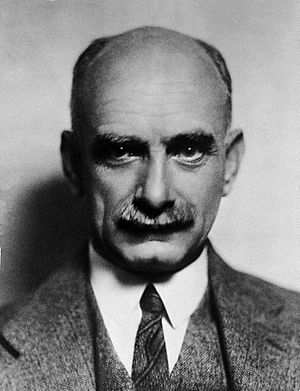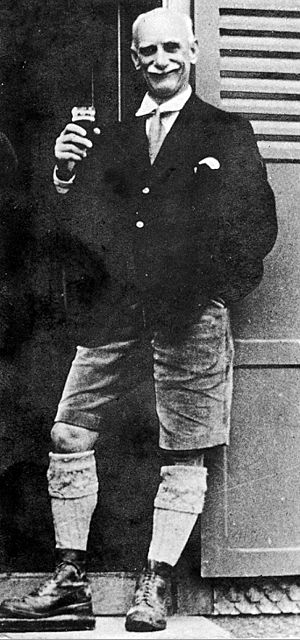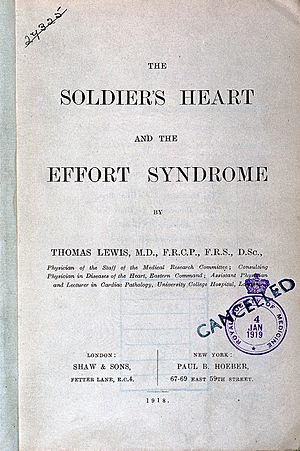Thomas Lewis (cardiologist) facts for kids
Sir Thomas Lewis (born December 26, 1881 – died March 17, 1945) was an important Welsh cardiologist, a doctor who specializes in the heart. He was known for creating the term "clinical science", which means using scientific research to help patients directly.
Contents
Early Life and School
Thomas Lewis was born in Taffs Well, a town in Cardiff, Wales. His father, Henry Lewis, was an engineer who worked in mines. His mother, Catherine Hannah, taught him at home for most of his childhood. He spent one year at Clifton College but had to leave because he was not well.
Even when he was young, Thomas wanted to be a doctor. At 16, he started studying science at University College, Cardiff. He finished his degree in three years with top grades. In 1902, he went to University College Hospital in London to train as a doctor. He graduated in 1905 with a special award called the gold medal. In the same year, he earned another science degree from the University of Wales for his research.
His Amazing Career
Thomas Lewis stayed at University College Hospital for his whole career. He started as a junior doctor. By 1907, he also worked at other hospitals, including the Royal Naval Hospital, Greenwich and the City of London Hospital. In 1911, he became a teacher of heart diseases at his hospital. He was promoted to a senior doctor in 1913.
Even as a junior doctor, Lewis started doing important research on the heart. He studied how the heart works, how the pulse beats, and how blood pressure changes.
Pioneering Heart Technology
From 1906, he worked with a Dutch scientist named Willem Einthoven. Einthoven had invented a machine called the string galvanometer, which led to the electrocardiograph (ECG). This machine records the electrical signals of the heart. Lewis was one of the first doctors to use the ECG machine to help patients. Because of his work, he is often called the "father of clinical cardiac electrophysiology." This means he was a leader in using electrical studies of the heart to treat people.
The ECG was first used in patient care in 1908. Thomas Lewis and another doctor, Arthur MacNalty, used it to find out if someone had a problem called heart block. In 1909, Lewis started a medical journal called Heart. He later changed its name to Clinical Science in 1933. In 1913, he wrote the first important book about using ECGs, called Clinical Electrocardiography.
Helping Soldiers in War
During the First World War, Lewis worked at a special hospital for soldiers with heart problems. He led a study on a condition called "soldier's heart." He found that this was not a true heart disease but more like a feeling of being very tired and anxious. He renamed it the "effort syndrome."
In 1918, he wrote a book about this condition. He also created special exercises to help many soldiers get better and return to their duties. For his important work during the war, he received special honors. He was made a Commander of the Order of the British Empire (CBE) in 1920 and was knighted in 1921, which means he became "Sir Thomas Lewis."
Later Research and Discoveries
After the war, Sir Thomas Lewis set up a special research department at his hospital. He continued to study heart rhythm problems. In 1925, he started looking at how blood vessels in the skin react. He had already shown in 1917 that tiny blood vessels called capillaries could contract on their own. Now, he studied how the skin reacts to injuries. This led to his 1927 book, The Blood Vessels of the Human Skin and their Responses.
He received a special award, the Royal Medal, in 1927 for his research on the blood system. Next, he studied problems with blood vessels in the arms and legs, especially Raynaud's disease. Finally, he focused on how pain works, writing a book called Pain in 1942. His 1932 book, Diseases of the Heart, became a very important book for doctors. In 1930, he described something called the Hunting reaction, which is when blood vessels in cold areas open and close to keep warm.
In 1930, he started the Medical Research Society. He received another very high award, the Copley Medal, in 1941 for his research on the heart. He was only the second doctor ever to receive this award. He also served as a vice-president of the Royal Society from 1943 to 1945.
Sir Thomas Lewis had a heart attack when he was 45 years old. After this, he stopped his heavy smoking habit. He was one of the first people to understand that smoking could harm blood vessels. He passed away from heart disease at his home on March 17, 1945, when he was 63.
Family
Sir Thomas Lewis married Alice Lorna Treharne James in 1916. They had three children together.
See also
- List of Welsh medical pioneers





